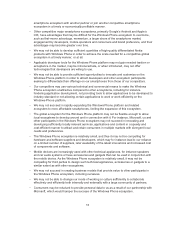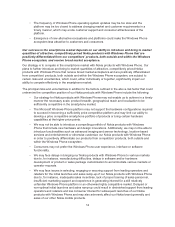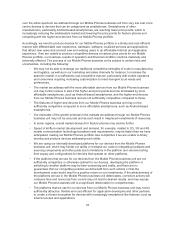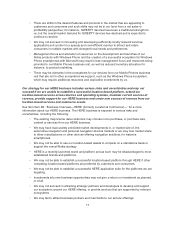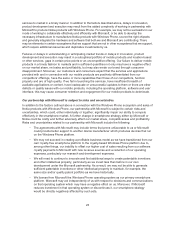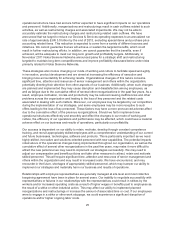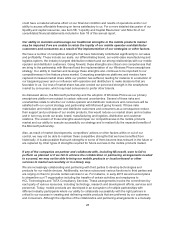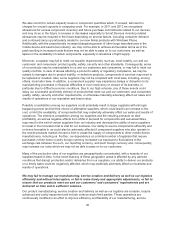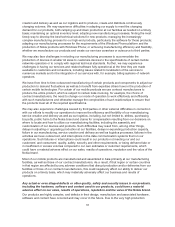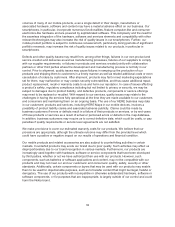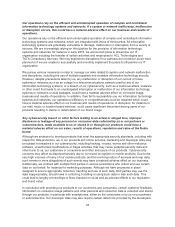Nokia 2012 Annual Report Download - page 24
Download and view the complete annual report
Please find page 24 of the 2012 Nokia annual report below. You can navigate through the pages in the report by either clicking on the pages listed below, or by using the keyword search tool below to find specific information within the annual report.services to market in a timely manner. In addition to the factors described above, delays in innovation,
product development and execution may result from the added complexity of working in partnership with
Microsoft to produce Nokia products with Windows Phone. For example, we may not be successful in our
mode of working to collaborate effectively and efficiently with Microsoft, or be able to develop the
necessary infrastructure to manufacture Nokia products with Windows Phone, source the right chipsets
and generally integrate the hardware and software that both we and Microsoft are contributing. There
may be elements in certain ecosystems that we support that are not in other ecosystems that we support,
which require additional resources and duplicative investments by us.
Failures or delays in understanding or anticipating market trends or delays in innovation, product
development and execution may result in a suboptimal portfolio of mobile products and location-based
or other services, gaps in certain price points or an uncompetitive offering. Our failure to deliver mobile
products in a timely fashion to markets and in sufficient quantities not only may have a negative effect
on our market share, net sales and profitability, but may also erode our brand through consumer
disappointment. Moreover, our customers and consumers expect that the services and applications
provided with and in connection with our mobile products are positively differentiated from our
competitors’ offerings, have the same or more capabilities than those of our competitors, function
properly and are of high quality. If we fail in launching the services, have insufficient breadth of
available applications or content, have inadequate or unsuccessful updates to them or there are other
defects or quality issues with our mobile products, including the operating platform, software and user
interface, this may cause consumer retention and engagement for our mobile products to deteriorate.
Our partnership with Microsoft is subject to risks and uncertainties.
In addition to the factors outlined above in connection with the Windows Phone ecosystem and sales of
Nokia products with Windows Phone, our partnership with Microsoft is subject to certain risks and
uncertainties, which could, either individually or together, significantly impair our ability to compete
effectively in the smartphone market. A further change in smartphone strategy either by Microsoft or
Nokia could be costly and further adversely affect our market share, competitiveness and profitability.
Risks and uncertainties related to our partnership with Microsoft include the following:
• The agreements with Microsoft may include terms that prove unfavorable to us or Microsoft
could provide better support to another device manufacturer which produces devices that run
on the Windows Phone platform.
• We may not succeed in creating a profitable business model as we have transitioned from our
own royalty-free smartphone platform to the royalty-based Windows Phone platform due to,
among other things, our inability to offset our higher cost of sales resulting from our software
royalty payments to Microsoft with new revenue sources and a reduction of our operating
expenses, particularly our research and development expenses.
• We will need to continue to innovate and find additional ways to create patentable inventions
and other intellectual property, particularly as we invest less than before in our own
development under the Microsoft partnership. As a result, we may not be able to generate
sufficient patentable inventions or other intellectual property to maintain, for example, the
same size and/or quality patent portfolio as we have historically.
• We license from Microsoft the Windows Phone operating system as our primary smartphone
platform. Microsoft may act independently of us with respect to decisions and communications
on that operating system which may have a negative effect on us. Moreover, if Microsoft
reduces investment in that operating system or discontinues it, our smartphone strategy
would be directly negatively affected by such acts.
23


